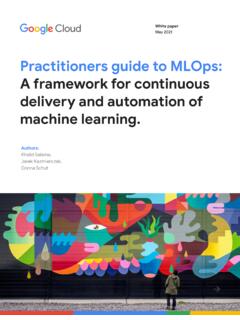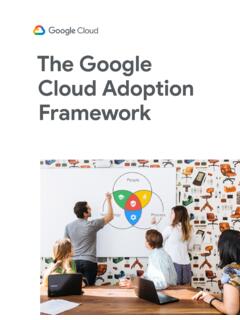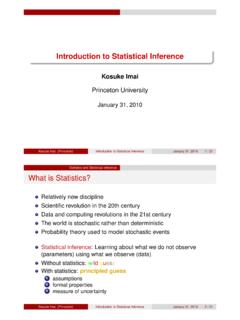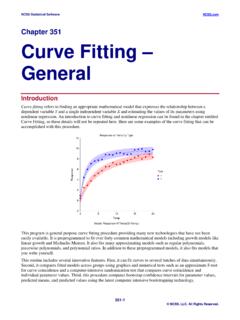Transcription of Exploratory Data Analysis for Feature Selection in Machine ...
1 Exploratory Data Analysis for Feature Selection in Machine learning Contents About this guide 3. 1. Introduction 4. 2. statistical data Analysis 4. Descriptive Analysis (univariate Analysis ) 4. Correlation Analysis (bivariate Analysis ) 5. Qualitative Analysis 6. Quantitative Analysis 7. Contextual Analysis 9. Time-based Analysis 9. Agent-based Analysis 10. 3. Visualization for data Analysis 12. 4. Feature Selection and engineering 13. Feature Selection based on descriptive Analysis 13. Feature Selection based on correlation Analysis 16. Feature Selection based on contextual Analysis 17. 5. EDA tools ecosystem 18. Existing tools 18. Feature comparison 19.
2 6. Use case illustration 20. Dataset 20. Descriptive Analysis 21. Data type and missing value 21. Numerical attributes 22. Categorical attributes 24. Correlation Analysis 25. Categorical versus categorical 25. Numerical versus numerical 26. Categorical versus numerical 28. Appendix 29. A. Hypothesis testing 29. B. Pearson correlation coefficient 30. C. Student T-test 31. 1. D. Pearson's chi-square test 32. E. ANOVA statistical test 3 3. F. Information gain 3 4. 2. About this guide The objective of this document is to provide comprehensive guidance on Exploratory data Analysis (EDA) from both an intuitive (that is, through visualization) and a rigorous (that is, statistical ) Analysis .
3 This guide aims to consolidate the different stories of conducting proper EDA, data cleaning, and Feature Selection in ML projects in a comprehensive approach that can easily be reproduced, so as to serve as a standard reference. Practitioners from different backgrounds and with varying experience in ML will benefit from following the process outlined. In detail, this guide provides practical information on: Deciding which Analysis or explorations are expected to be performed, based on the datasets (and prediction target) at hand Performing the selected Analysis , taking into consideration: Rigorous data Analysis , focusing on the relationship between features or between features and labels, with rigorous reasoning (theory).
4 Descriptive Analysis of each attribute in a dataset for numerical, categorical, and textual attributes Correlation Analysis of two attributes (numerical versus numerical, numerical versus categorical, and categorical versus categorical). through qualitative and/or quantitative Analysis Time- and agent-based c ontextual Analysis for a deeper understanding of the dataset Visualizations that help provide an intuitive understanding of the Analysis result A survey of the existing tools that are most suitable Determining the appropriate Feature processing , based on the Analysis result and domain knowledge A concrete u se case is also presented for the Adult Census Income dataset that applies the Analysis and visualizations introduced.
5 Note : Feature Selection itself is a comprehensive topic that generally includes filtering (forward and backward) methods, wrapper methods, and embedded methods. The Feature Selection recommendations discussed in this guide belong to the family of filtering methods, and as such, they are the most direct and typical steps after EDA. We recommend that interested readers check the following review for a complete overview of Feature Selection . 3. 1. Introduction Machine learning (ML) projects typically start with a comprehensive exploration of the provided datasets. It is critical that ML practitioners gain a deep understanding of: The properties of the data : schema, statistical properties, and so on The quality of the data : missing values, inconsistent data types, and so on The predictive power of the data : for example, the correlation of features with the target This process lays the groundwork for the subsequent Feature Selection and engineering steps, and it provides a solid foundation for building good M L models.
6 It is often said that if ML is the rocket engine, then the fuel is the (high-quality) data we can feed to ML algorithms. E xploratory data Analysis (EDA), Feature Selection , and Feature engineering are frequently considered together, and they are all important steps in the M L journey. How the results of proper EDA can influence the subsequent decisions is not a trivial question given the complexity of the data and the problems we are currently dealing with. 2. statistical data Analysis This section outlines the different statistical analyses performed, the motivation behind them, and examples of each. The goal of these analyses is to determine the q uality of features and their predictive power in contrast with target value or label.
7 They provide a more comprehensive understanding of the data and should be the first step in studying any dataset, not just those for ML projects. The exploration of the data is conducted from three different angles: d escriptive , correlative , and contextual . Each type introduces information on the predictive power of the features and enables an informed decision based on the outcome of the Analysis . The methodology and process outlined in this section lays the foundation for the decision process described in Section 4. Descriptive Analysis (univariate Analysis ). Descriptive Analysis (or univariate Analysis ) provides an understanding of the characteristics of each attribute of the dataset.
8 It also offers important evidence for Feature Selection in a later state. 4. The following table lists the suggested Analysis for attributes that are common, numerical, categorical, and textual. Attribute type Statistic/calculation Details Data type Attribute's data type Percentage of missing values Common Missing values Note: The statistics that follow in this table should, in general, exclude the detected missing values. Quantile statistics Q1, Q2, Q3, min, max, range, interquartile range Mean, mode, standard deviation, median Numerical Descriptive statistics absolute deviation, kurtosis, skewness Distribution histogram Based on the appropriate number of bins Number of unique values for the categorical attribute Cardinality For example: in the case of gender, the number of Categorical unique values is generally two: male and female.
9 Unique counts Number of occurrences for each unique value of the categorical attribute Tokens Number of unique tokens Textual Distribution of document frequency and term frequency DF/TF. with or without standard English stop words Further Analysis will provide a better understanding of the relationships between the dataset attributes. This is the aim of correlation Analysis . Correlation Analysis (bivariate Analysis ). Correlation Analysis (or bivariate Analysis ) examines the relationship between two attributes, say X and Y , and determines whether the two are correlated. This Analysis can be done from two perspectives for various possible combinations: Qualitative Analysis .
10 C omputation of the descriptive statistics of dependent numerical or categorical attributes against each unique value of the independent categorical attribute. This perspective helps to intuitively understand the relationship between X and Y.. Visualizations are often used together with qualitative Analysis as a more intuitive way of presenting the result. 5. Quantitative Analysis . A. quantitative test of the relationship between X. and Y, based on a hypothesis-testing framework. This perspective provides a formal and mathematical methodology to quantitatively determine the existence and/or strength of relationship. The motivation for performing correlation Analysis is to help determine: Which attributes are not predictive, in terms of correlation with the target value.














